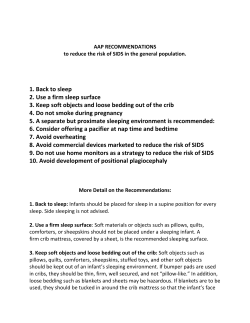
What is deformational plagiocephaly?
What is deformational plagiocephaly? The most common craniofacial problem today is called ‘plagiocephaly’, literally meaning ‘oblique head’. Deformational plagiocephaly, also known as ‘positional plagiocephaly’, refers to a misshapen (asymmetrical) head shape. Information for healthcare professionals Deformational Plagiocephaly What causes deformational plagiocephaly? This skull deformity results from repeated external pressure to an infant’s skull due to the head being in one position for extended periods (e.g. in a cot or car seat). In these ‘positional’ deformities, the occiput (back part of the head) is most often flattened. When viewed from above, the head will take on a parallelogram shape and the forehead on the affected side is typically prominent. The ear on the affected side may be pushed forward compared with the other side. There may also be facial asymmetry, with the affected side having a fuller cheek. How is deformational plagiocephaly different from craniosynostosis? Department of Plastic and Maxillofacial Surgery Royal Children’s Hospital Flemington Road Parkville Victoria 3052 www.rch.org.au/plastic Telephone: (03) 9345 5391 Facsimile: (03) 9345 6585 Email: plastic.surgery@rch.org.au Infants with craniosynostosis also present with asymmetrical skull shapes. In craniosynostosis, however, the skull deformity results from premature fusion of one or more of the skull sutures. There is no premature sutural fusion in deformational plagiocephaly. The skull and facial asymmetry in craniosynostosis is typically more severe than that of deformational plagiocephaly. Craniosynostosis and deformational plagiocephaly can usually be distinguished by physical examination. Skull X-rays and CT scans may sometimes be required to differentiate synostotic from deformational plagiocephaly. Key differences Deformational plagiocephaly Craniofacial features Craniosynostosis Parallelogram Rhomboid head head shape shape Nose generally Nose root straight deviates towards Ear more fused suture anterior Orbit on affected side enlarged Eyebrow elevated Ear posterior Head Normal rate of circumference head growth Progressive slowing in head growth Causal factors External pressure, e.g. back sleeping, restricted intrauterine environment, muscular torticollis, prematurity Internal mechanisms Common causes of deformational plagiocephaly The most common forms of treatment are counter positioning and/or helmet therapy. Back sleeping Infants who sleep on their backs and/or in car seats without alternating their position are at increased risk of deformational plagiocephaly. Counter positioning Counter positioning is recommended where a helmet is not warranted and is most effective between birth and 4 months of age. This involves consistently repositioning the infant’s head so that they do not rest on the flat spot. Increased tummy time and side lying play when the infant is awake is also encouraged. Positioning with rolled up towels can sometimes be of assistance. Counter positioning techniques can be taught by health professionals, including maternal and child health nurses and paediatric physiotherapists. Muscular torticollis This is a congenital condition caused by shortening or tightening of one or more of the neck muscles. This causes the infant’s head to tilt and/or turn to favour one particular direction. Prematurity The cranial bones of premature infants are very soft and malleable following birth, and therefore more susceptible to external pressures. In utero constraint Less frequently, a baby is born with a flattened skull due to a restricted intrauterine environment or ‘crowding’ (i.e. multiple births, breech position, small maternal pelvis). Treatment options Diagnosis Clinical examination Clinical examination Imaging scans Treating practitioner GP and/or paediatrician. If concerns, refer to a craniofacial surgeon Craniofacial surgeon Treatment Counter positioning and/or helmet therapy Cranial expansion surgery Treatment will vary depending on the nature and severity of the deformity. Many mild cases do not require any treatment and the condition will improve spontaneously when the infant begins to sit. Early diagnosis of co-existing torticollis is important as this does require treatment by a paediatric physiotherapist. More severe deformity may warrant treatment. In these cases early referral is advised (between 4-8 months of age) as the majority of cranial growth is achieved during the first 12 months of life, and the greatest amount of correction will be achieved during this time. Helmet therapy In moderate to severe cases of deformational plagiocephaly, and/or where a trial of counter positioning has failed, a cranial remodelling helmet may be recommended. The helmet assists the skull moulding process by removing the pressure over the flat area, allowing the skull to grow into the space provided. Helmets are most effective between 4-8 months of age. The helmet is made of an outer hard shell and is lightweight with a foam lining. They are custom-made to fit the infant’s head by an experienced orthotist. This requires the orthotist to make a casting of the infant’s head. The average duration of helmet therapy is usually 2-6 months, depending on the age of the infant and the severity of the deformational plagiocephaly. The helmet is required to be worn for 23 out of 24 hours every day. Frequent adjustments are also required on a fortnightly, sometimes weekly, basis to ensure proper head growth and optimal correction of the deformity.
© Copyright 2025















